Hayden Fowler's interdisciplinary practice reflects on the consequences of the increasing separation between humanity and nature at a time when it is becoming more and more difficult to define what is natural. In his highly engineered scenarios, animal and human subjects not only occupy the same decadent, imaginative space but share the same desire. It is a suffocated desire, however, in which the remarkable displays of preening and adornment associated with sexual behaviour atrophy into a cloying narcissism that signals a breakage between species.
Fowler countenances a world of inter-species subjectivity that may disgust some and arouse others. His fables and myths look back to a more savage pre-modern era while simultaneously evoking a sci-fi future. This suspension of chronological time is both an aesthetic and a discursive device underpinning the theatricality of his image making while cooling our haste to claim social progress.
In Call of the Wild, Fowler undergoes the tattooing of an expansive pair of extinct Huia birds, turning his attention to the most prized specimen of all – himself. This photo-media and sound installation developed out of a live performance, which he presented at the 2007 Auckland Festival. Sarah Smuts- Kennedy documented the weeklong performance and the resulting photographs are accompanied by a soundtrack of surviving New Zealand birds, which was also part of the original performance.
Fowler and his collaborator, the tattoo artist Captain Marvin Lerning, are framed by the front window of a boutique in Auckland's fashion high street, which sees the Huia return to the fashionable circles that were responsible for its demise. In 1901, the presentation of Huia tail feathers to the visiting Duke of York resulted in a London fashion craze which contributed to its extinction by 1907. Fashion, that corollary to courtship and mating, created a demand for Huia feathers that reduced a symbol of Maori authority to an exotic accessory.
Fowler's performance exercises a fascination because of its irreversibility. Just as the Huia can never be brought back from extinction so Fowler's torso can never be returned to its original state. Fowler's gesture combines an embodied politics with an appetite for acts of defiance. The resulting images are compelling because of the manner in which our apprehension of Fowler's pain is held in check thus allowing for a considerable scope of ideas to be generated.
On first impression, our sensitivity to the bruising and exhaustion being experienced by Fowler is contained by its aestheticisation. The artist and the tattooist are suspended in a chamber far removed from the folklore of back room tattoo parlours. Despite the presence of needle and blood, the images carry reassurances.
Most immediately, they are the pristine conditions of the laboratory-like surrounds and the crispness of the uniforms which are styled in the manner of the faux scientific garb worn by sales assistants at cosmetic counters. Hygiene and correction prevail. This sense of control in the performance is carried forward by the tightly cropped composition of the final images selected for gallery display.
Of course, sensation of Fowler's pain is also amplified by the whiteness of the chamber and the brightness of the light. Any second thoughts by him or lack of resolution about the performance are visible to all. Every imperfection is plain to see – the stretch marks, the blemishes and the discolouration of his skin. Despite Fowler's vigour, the tattoos will degrade over time as Fowler's skin and body age.
Fowler's adorned body is not the waxed and tweezered fashion artefact nor is the tattooist an entirely reassuring presence. Looking closer, Fowler's accomplice appears to have a 'club foot', to have slipped through the exacting social protocols of the twentieth first century. This suggestion of deformity introduces an undercurrent of menace. Such is Fowler's identification with the Huia, however, that he is prepared to join with this splendid creature and subject himself to the violence of the performance and of the public gaze. Ultimately, it is this act by Fowler that resurrects the Huia through the combining of Fowler and the bird's bloodstreams.
In the photographs that portray the tattoos we marvel at both the skill of the tattooist and also the plumage of the Huia. The tattooing traditions of Pacific cultures are invoked while the fineness of the tattooing brings to mind drawings by the naturalists that accompanied the historic voyages of mapping to the Southern Hemisphere. A vitality is bestowed on the Huia by the tattooed line imbuing it with contemporary and historic significance.
When Call of the Wild was shown earlier this year at Fremantle Arts Centre, a remarkable interaction began, with the birds in the gardens surrounding the Centre calling across time and space to their recorded and mediated counterparts in the gallery.
Jasmin Stephens, Curator
Fremantle Arts Centre, July 2008
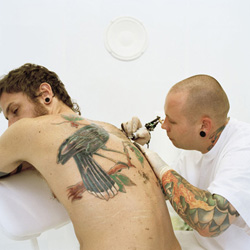
image: Call of the Wild, 2007
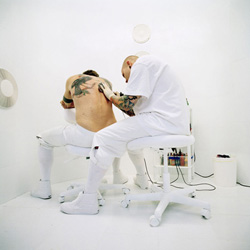
image: Call of the Wild, 2007
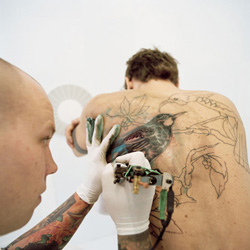
image: Call of the Wild, 2007
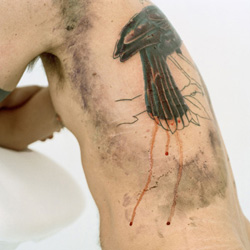
image: Call of the Wild, 2007
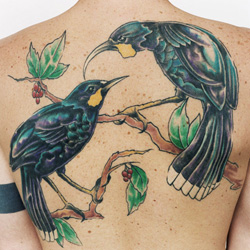
image: Call of the Wild, 2007
